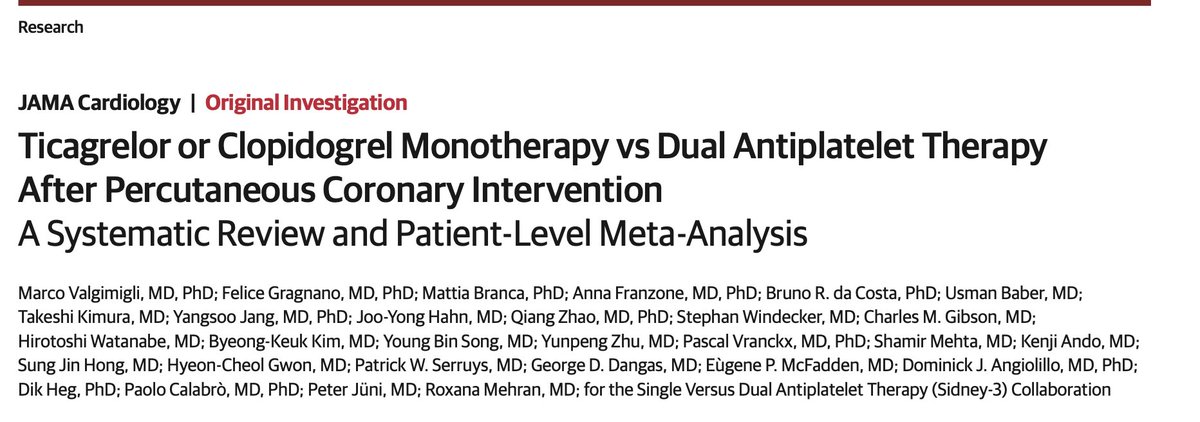Transcatheter Aortic-Valve Replacement for Asymptomatic Severe Aortic Stenosis: @NEJM
🥸 I was at #TCT2024 all day - just got to a desk @TCTMD
😱 Summary of EARLY TAVR trial
👇👇👇
🥸 I was at #TCT2024 all day - just got to a desk @TCTMD
😱 Summary of EARLY TAVR trial
👇👇👇

🥸1️⃣ The EARLY TAVR trial focused on patients with asymptomatic severe aortic stenosis and preserved LV function to see if early transcatheter aortic-valve replacement (TAVR) outperformed standard surveillance.
🥸2️⃣ 901 patients (75.8 years average) were randomly split: 455 received early TAVR, 446 were under clinical surveillance per current guidelines, with close monitoring for worsening symptoms or health declines.
🥸3️⃣ Primary endpoint measured was a composite of death, stroke, or unplanned cardiovascular hospitalization to assess how each approach fared in serious health outcomes.
🥸4️⃣ TAVR group had 26.8% reach the primary endpoint vs. 45.3% in the surveillance group, showing early intervention had fewer adverse outcomes than watchful waiting (HR 0.50; CI 0.40-0.63; P<0.001).
😱 Primary endpoint = death, stroke or unplanned hospitalization for CV causes
😱 Primary endpoint = death, stroke or unplanned hospitalization for CV causes
🥸5️⃣ Survival rate was similar across groups: TAVR group saw 8.4% deaths compared to 9.2% in the surveillance group.
🥸6️⃣ Stroke risk was notably lower in TAVR patients (4.2%) vs. surveillance (6.7%), suggesting early intervention may offer neurological protection.
🥸7️⃣ TAVR group had less unplanned cardiovascular hospitalizations (20.9%) compared to 41.7% in the surveillance group, showing TAVR’s role in lowering acute hospital visits.
😱 Driving the primary outcome!
😱 Driving the primary outcome!
🥸8️⃣ Median follow-up was 3.8 years, and during that period, 87% of the surveillance group ultimately needed aortic-valve replacement.
🥸9️⃣ Quality of life assessments favored TAVR at 2 years, where patients in the TAVR group maintained higher scores with fewer limitations on daily activities.
🥸🔟 The TAVR approach better preserved heart function, reducing the deterioration in both left ventricular and atrial health compared to surveillance.
🥸1️⃣1️⃣ TAVR patients had fewer episodes of symptom escalation requiring intervention, while the surveillance group showed more late-stage symptoms at time of surgery.
🥸1️⃣2️⃣ Stroke rates within the first 30 days post-procedure were low for both groups, but surveillance showed a slightly higher rate, which reinforced the TAVR’s early stability advantage.
🥸1️⃣3️⃣ Cardiac function tests revealed TAVR’s benefit: the surveillance group’s metrics showed a decline before intervention, while TAVR patients maintained stable measurements longer.
🥸1️⃣4️⃣ 71.4% in surveillance had a valve replacement within 2 years, with one in four needing it within the first 6 months.
🥸1️⃣5️⃣ Patients in the surveillance group often experienced more symptoms and reduced exercise capacity before transitioning to the TAVR procedure.
🥸1️⃣6️⃣ TAVR’s early intervention path reduced unplanned admissions and showed a safety profile comparable to clinical surveillance over time.
🥸1️⃣7️⃣ Kaplan-Meier analysis confirmed TAVR’s advantage across endpoints; TAVR patients had fewer complications even with the same median follow-up time.
🥸1️⃣8️⃣ Over 30% of surveillance patients displayed advanced symptoms by the time of their valve replacement, which may indicate potential delays in intervention.
🥸1️⃣9️⃣ No cardiovascular deaths occurred within 30 days post-procedure in either group.
🥸2️⃣0️⃣ Conclusion: Early TAVR improves outcomes for severe asymptomatic aortic stenosis, lowering risks of stroke, death, and hospitalizations compared to traditional surveillance.
• • •
Missing some Tweet in this thread? You can try to
force a refresh










